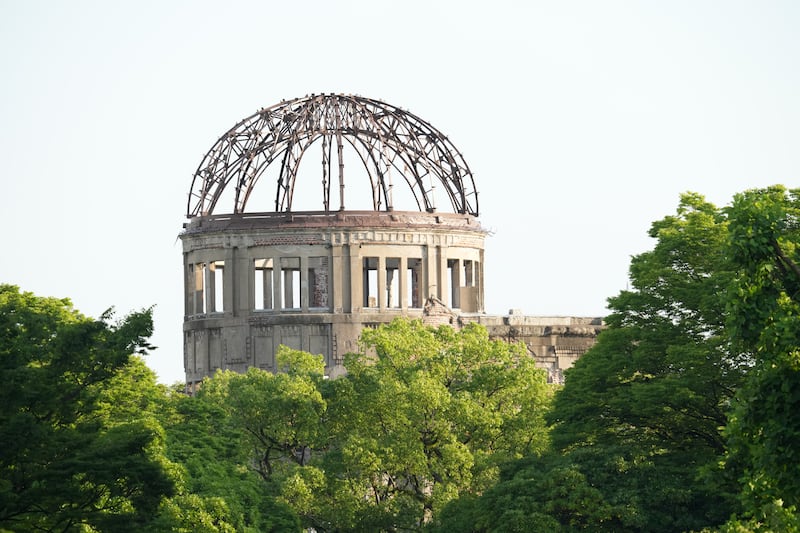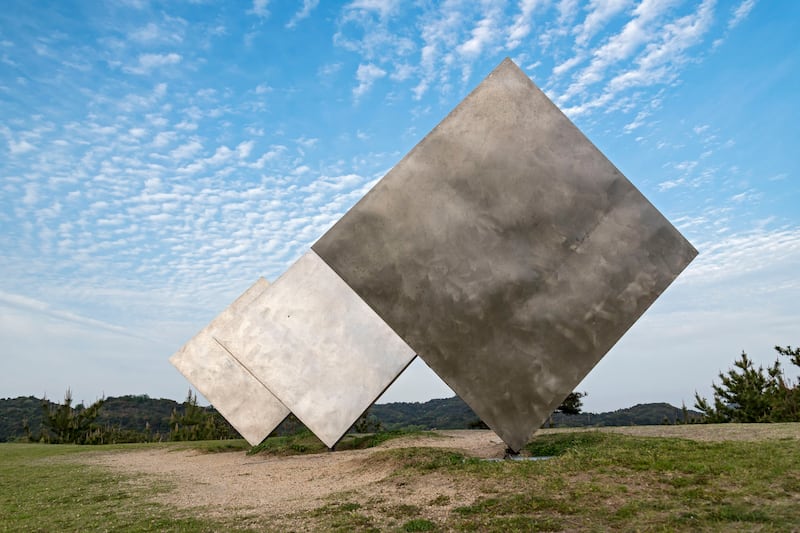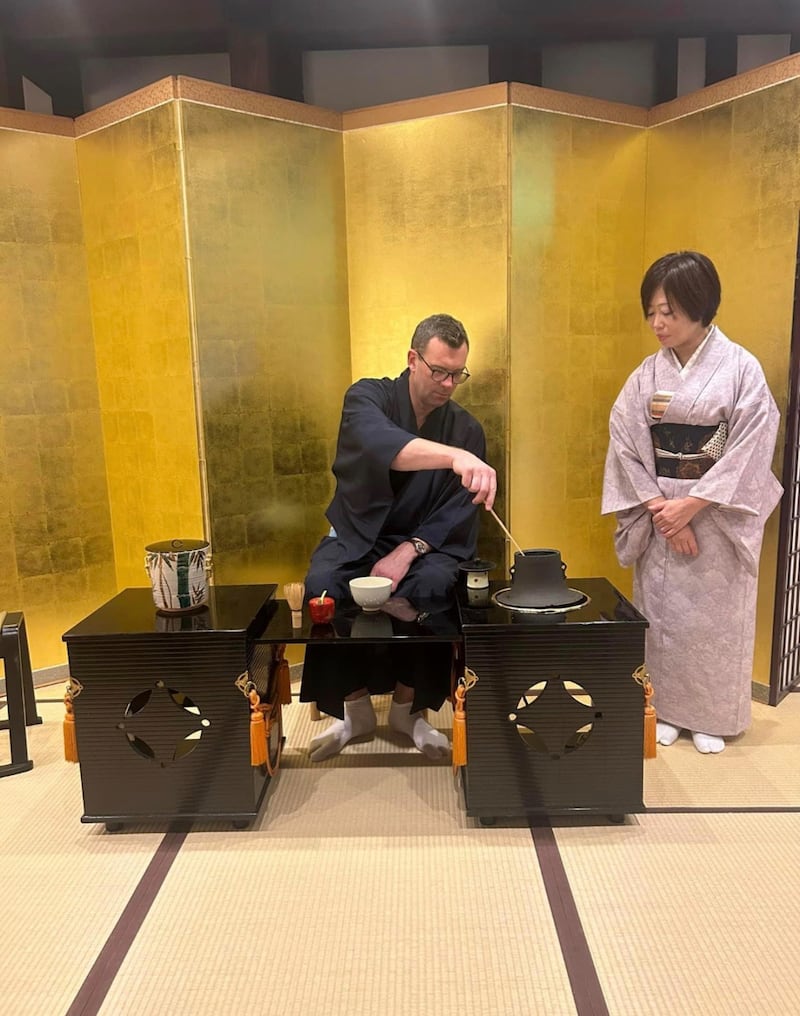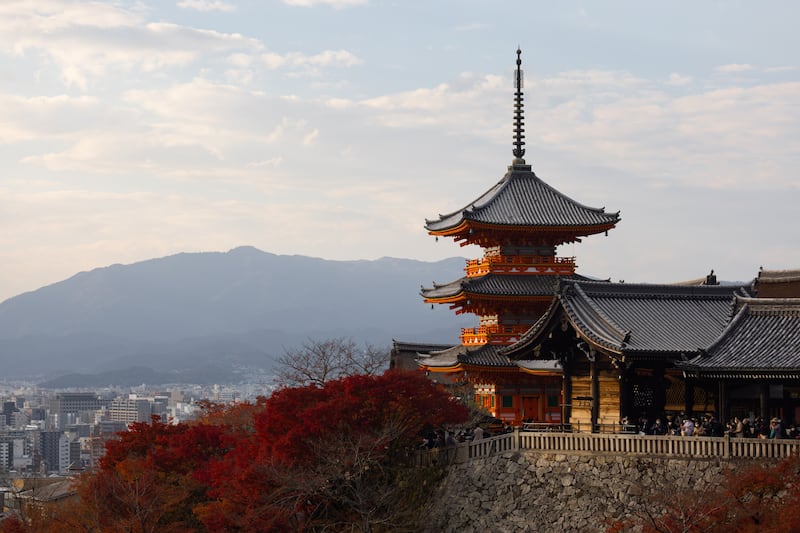On the eve of our once-in-a-lifetime family trip to Japan, my wife presented each of us with a stylish notepad – a diary of our journey that, after day one, stayed almost completely empty.
It turned out that we were all just too busy, too dazed, too thrilled and sometimes just too confounded by our surroundings to even think about writing longhand notes. Instead, Japan unfolds like a novel, or maybe a manga comic, our 17 days jammed with pig cafes, tea ceremonies, bullet trains and robot cafes.
For our children, aged nine, 11 and 13, it was their first long-haul event. Our first stop was Tokyo, the vast, ultimate city. Our local train and metro station, Shinjuku, is the busiest in the world and seems a daunting prospect, but every mode of transport has an English pre-record informing you of your stop, and every station has prominent English-language instructions.
On our trip we have two days with a guide, one in Tokyo and another in Kyoto, but otherwise we are travelling solo. With our Tokyo guide, Mieko, we quickly make for the famous Shibuya Scramble Crossing and then a robot cafe at Tokyo Plaza, where mobile units happily chat to you as you sip your coffee.
Then it is off to the Meiji Jingu shrine, the city’s most famous, set in an expansive park right next to Omotesando, known as Tokyo’s Champs-Elysées. Here we got a first taste of the processional, maybe even superstitious air of Japan – the bowing before entering the gates, the pageantry inside, the writing of good-luck messages. In the warren of streets nearby you find the other Japan – the ultra modern and the decidedly offbeat, including the Mipig Cafe, a tiny outlet where booking is essential and where you get to nuzzle some miniature-pigs while sipping a Coke. It is a suitably bonkers but brilliant idea. The pigs are adorable and, we are assured, very well looked after.

Before departing Tokyo we spend a day in Disneyland Japan and attend a manga drawing class, as well as paying a visit to Sensō-ji, one of the city’s main Buddhist temples, which is surrounded by older, traditional Japanese housing, a window into a past that is embraced and venerated by all generations.
Next stop, Hakone, is a magical valley town not far from the capital and the focus of a spectacular range of activities, including a ride on the world’s second-longest cable car up to Mount Owakudani. First the Hakone Tozan train see-saws up the mountain, before the car makes the final ascent. It offers incredible views of Tokyo in the distance, but the true sights are at the summit, where sulphurous fumes billow from the mountain. You can eat a hard-boiled egg cooked in the hot springs – according to legend, this will add seven years to your life. But even if you’re left burping like the mountaintop, the cable car takes you back down to the serenity of Lake Ashinoko, where a replica pirate ship will cross to the other side. One crammed bus ride later we have a full Japanese multi-course meal in traditional kimonos, before relaxing in an onsen, or hot spring bath (in the nip), located on outside balconies so you can see the stars twinkle overhead.
After this 24-hour activity blitz, it is time for a four-hour train ride to Hiroshima, where the main streets are festooned with 3D advertising billboards alongside clear examples of the city’s uniquely preserved history, such as a bank front left untouched since the atomic blast of August 6th, 1945.

Hiroshima is bright, vibrant and friendly, but it is maybe unique in how it has preserved the darkest day in its history. We make the short walk along Hiroshima’s central river to the stark remains of the Genbaku Dome, also known as the A-bomb Dome. Since 1996 it has been registered on the World Heritage List, and no wonder: set against a dazzling blue sky, it is a moment in aspic, when Little Boy detonated over the city, causing untold devastation. Cross the foot bridges into the Peace Memorial Park and there is more, including a superb museum tour, which doesn’t spare the visceral nature of the damage caused by the bomb. It is deeply affecting to observe the different school groups gathered at the various memorials in the park, all respectfully hushed as this pivotal moment in world history is explained to them. Later two girls and a boy, all in uniform, approach and present us with some origami figures, part of their school project to promote connectedness and common cause at a place where the world changed forever.

Hiroshima is also our base for a day trip to Miyajima, a wooded island accessible via a short ferry crossing. Here is one of the most photographed sites in Japan – the floating torii gate of the Itsukushima Shrine. But there is so much else here, such as the shops and stalls baking Momiji Manju, small maple-shaped cakes with various fillings that are a delicious local speciality, particularly for the herds of wild deer which trot around, undeterred by the hordes. A relatively short climb from the buzzing stalls takes you up to different temples and small cafes, all set around the dense forest that forms the centre of Miyajima.

Then we head to another island, the truly amazing artists’ haven of Naoshima. A Mediterranean climate envelops a gorgeous island full of ramshackle settlements, every one apparently stacked with galleries. Art is everywhere. We spot a marking on the local map for a “tea cup” and think it was a cafe – when we get there, it is an actual, Wonka-sized sculpture of a teacup. Picture our faces.
[ The Rockies Road from Dublin to Colorado’s natural highsOpens in new window ]

Our hotel, the ultra-stylish Benesse House, has its own eye-catching artworks but little compares to the seaside setting and the distant views of the city of Takamatsu, like something from Bladerunner in the fading evening light. We also visit the nearby Chichu Art Museum, built almost entirely underground so that it amplifies the sky at various points. It is home to works by world-famous artists such as James Turrell, Walter de Maria and Claude Monet, five of whose Water Lilies series are exhibited here. Art lovers, foodies, sun worshippers, newly-weds, fans of woodplated shacks – Naoshima is the place for you, made all the more memorable by the presence of the iconic red and yellow pumpkin sculptures by Japanese figurehead Yahoo Kusama, which, along with its alluring pace of life, is the island’s signature.
Next we board the bullet train to Kyoto, Japan’s cultural capital. Immediately on arrival we make for a nearby traditional tea ceremony in a Machiya, a faithfully restored wooden town house. When the itinerary says “ceremonial”, it isn’t joking. The kimono robing and tea preparation is lengthy, detailed and fascinating. Every aspect is explained by the in-house experts, giving a deep insight into what might appear to be the more antiquated parts of Japanese culture, but which are still held dear.

Kyoto is spectacular, from the soaring Nidec Kyoto Tower and the huge number of Buddhist temples and Shinto shrines to its pulsating downtown area. With our day guide, Keiko, we visit the Buddhist Kiyomizu-dera shrine or “Pure Water Monastery”, where early-morning attendance is advised to avoid the huge crowds. It was first established more than 1,200 years ago, and the main building is almost 400 years old and, remarkably, does not have a single nail, its perfectly latticed cedar keeping everything upright. Keiko explains the age-old custom of “jumping off the stage at Kiyomizu”, meaning that if someone plunges down the 43ft drop and survives, their wishes will, according to legend, be granted.
Happily, the custom was outlawed in 1872. We also fumble blindly through Zuigu Hall, a subterranean area of complete darkness where you can make a wish on finding the Zuigu stone. All this appeals to my superstitious nature, but as Keiko explains, the various temples and shrines coexist in the same way that the two faiths, Buddhism and Shintoism, fold together in the lives of so many Japanese.

We also visit the expansive Nijo Castle elsewhere in Kyoto, and Kinkakuji, the Golden Pavilion, one of the city’s most famous temples, and the Ryoanji Temple, home to the famous and endearingly simple rock garden, which is at least 500 years old. You simply have to sit down and stare at the stones and sand, contemplating ... well, everything.
We make a day trip to the lovely town of Arashiyama and its famous Bamboo Grove, with the area also the base point for a climb to the Iwatayama Monkey Park, where macaque monkeys run amok. But the real buzz in Kyoto is strolling downtown, under the glowing lights and amid the throng, a sensation only heightened by our last stop, the nearby city of Osaka. Just when we are thinking everything might be just too clean and orderly in Japan, here is a city with an edge, the one place where you can spot crashed-out revellers, where people smoke cigarettes while riding a bike. Dotonbori, the supreme downtown district, is wall-to-wall electronic billboards, including the famous Glico Man sign showing a runner crossing the tape, which was first displayed in 1935.

Osaka is amazing, full of brilliant markets and coffee shops. Such is the thrill of ambling around that we park any high culture in favour of people watching, a mind-blowing trip to Universal Studios aside, and my own brief personal pilgrimage to famous music shop Flake Records, where I encounter a bewildering array of CDs and vinyl and a pleasingly taciturn owner.
In short: we love Japan. I love how, for a cutting-edge nation, they use paper for almost everything, including train tickets. I love the politeness, and the occasional bafflement when something doesn’t go exactly to plan (for example, having caught an earlier train to head to the airport, we stand in the area between carriages so as not to take anyone else’s seat, almost sparking a diplomatic incident). I love the colours of the cherry blossoms and how even the most futuristic city is ringed by dense woodlands. I love how you can, conceivably, eat every day purely from the goodies at the 7-11, and how many things seem extrasensory, such as when you enter an arcade and are immediately assailed by an aural overload. The dizzying nature of it all is maybe best summed up by our experience of the Harry Potter ride at Universal Studios, when it stalls unexpectedly for a few minutes, leaving us strapped in and upside down in our seats. When it resumes and brings us back to the ground, we think we are being ushered out but instead we are all immediately put back in for another go, green around the gills, but entranced by the thrill of it all.
So the diaries stay empty, but we come home with bags of ephemera – ticket stubs, flyers, pamphlets – plus all the photos, and the memories, and a real desire to return, sooner rather than later. But on the very first page of his diary, my son somehow captures a sense of everything that is to follow. “We had a very nice robot, he played games and served us drinks and food,” he has written of our visit to Pepper Parlor. “I am happy.”


















